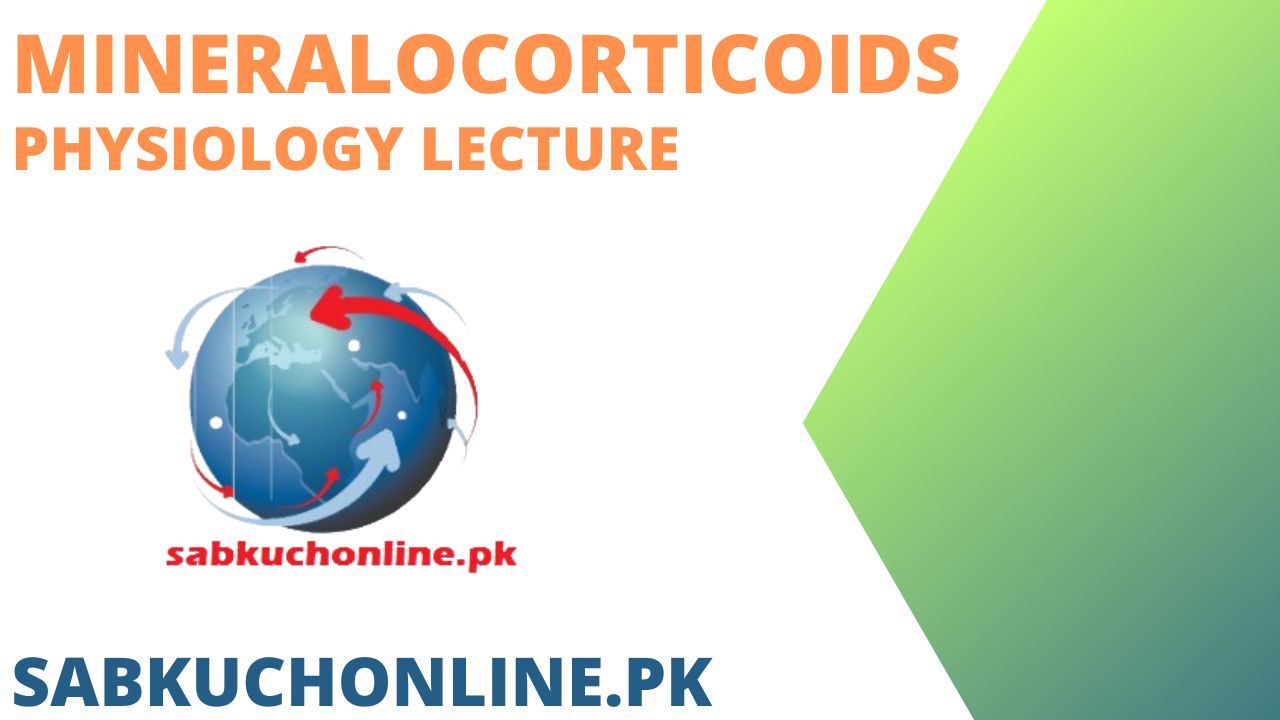Learning Objectives
At the end of the lecture all the students
should be able to:
- Explain the location of release of mineralocorticoids.
- Elucidate important mineralocorticoids.
- Elucidate the general features of aldosterone.
- Know the functions of mineralocoticoids.

Mineralocorticoids
- Aldosterone
- Deoxycorticosterone
- Corticosterone
- 9α- Fluorocortisol
- Cortisol
- Cortisone

Why cortisol does not have much mineralocorticoid effects?
- the renal epithelial cells express the enzyme
11β-hydroxysteroid dehydrogenase - converts cortisol to cortisone
Aldosterone
A steroid hormone
Essential for life (acute)
Responsible for regulating Na+ reabsorption in the distal tubule and the cortical
collecting duct
Target cells are called “principal (P) cell”
Stimulates synthesis of more Na/K-
ATPase pumps




Functions of Mineralocorticoids
- They increase sodium chloride and water reabsorption from the distal convoluted tubules and collecting ducts of the kidney.
- They increase excretion of potassium and hydrogen at the same sites of the nephron.
- They also enhance sodium and water reabsorption in the salivary gastric and sweat glands.
- As a result, there is increase in plasma sodium, water, and pH and decrease in plasma potassium.
- Excess aldosterone causes hypokalemia & muscle weakness
- Too little aldosterone causes hyperkalemia & cardiac toxicity
- Excess aldosterone increases tubular (intercalated cells) hydrogen ion secretion, with resultant mild alkalosis
- Excess aldosterone increases extracellular fluid volume and arterial pressure but has only a small effect on plasma sodium concentration.
- Why?
- With excess aldosterone plasma volume increases,
- The rise in arterial pressure then increases kidney excretion of both sodium and water, called pressure natriuresis and pressure diuresis, respectively.
Aldosterone Escape
- This return to normal of sodium and water excretion by the kidneys as a result of pressure natriuresis and diuresis is called aldosterone escape.
Low Aldosterone
- Sodium is lost
- ECF volume is lost
- The result is severe extracellular fluid dehydration and low blood volume, leading to circulatory shock.
Summary

Regulation of Aldosterone
Increased potassium ion concentration
Increased angiotensin II concentration
Increased sodium ion concentration : very slightly decreases
ACTH from the anterior pituitary gland is necessary for aldosterone secretion but has little effect in controlling the rate of secretion.

Control of Aldosterone secretion
Role of the renin- angiotensin system:
- Angiotensin II binds to specific receptors on zona glomerulosa, stimulating its growth and vascularity.
- It also stimulates aldosterone synthesis and secretion.
Atrial natriuretic peptide (ANP): inhibits renin
secretion and also inhibits aldosterone secretion.
Hormones of the Adrenal Cortex

Addison’s Disease
- Primary adrenal insufficiency
- Mineralocorticoid Deficiency.
- Glucocorticoid Deficiency.
- Primary adrenal insufficiency
- Mineralocorticoid Deficiency.
- Water loss, sodium and chloride loss
- Mild acidosis and hyperkalemia
- Glucocorticoid Deficiency.
- Inability to maintain glucose levels
- Decreased gluconeogenesis
- Reduces the mobilization of both proteins and fats from the tissues, thereby
- depressing many other metabolic functions of the body.
- Patients are susceptible to the deteriorating effects of different types of stress, and
- even a mild respiratory infection can cause death.
- Melanin Pigmentation.


Decrease cortisol.
Decreased negative feedback mechanism.
- Increased rates of ACTH secretion, as well as simultaneous secretion of increased amounts of MSH.
- The large amounts of ACTH probably cause most of the pigmenting effect because they can stimulate formation of melanin by the melanocytes in the same way that MSH does.
- This critical need for extra glucocorticoids and the associated severe debility in times of stress in patients with Addison’s Disease is called

Conn’s Syndrome
- Primary Aldosteronism
- Tumor of zona Gromerulosa
- Hyperplastic adrenal cortices secrete aldosterone rather than cortisol.
The most important effects are:
- Hypokalemia
- Mild metabolic alkalosis
- A slight increase in ECF and blood volume
- A little increase in plasma sodium concentration
- Almost always, hypertension.
Other effects
- occasional periods of muscle paralysis caused by the hypokalemia.
One of the diagnostic criteria of primary
aldosterone’s is a decreased plasma renin concentration.
Treatment:
Surgical removal of the tumor.
Pharmacological antagonism of the mineralocorticoid receptor.
